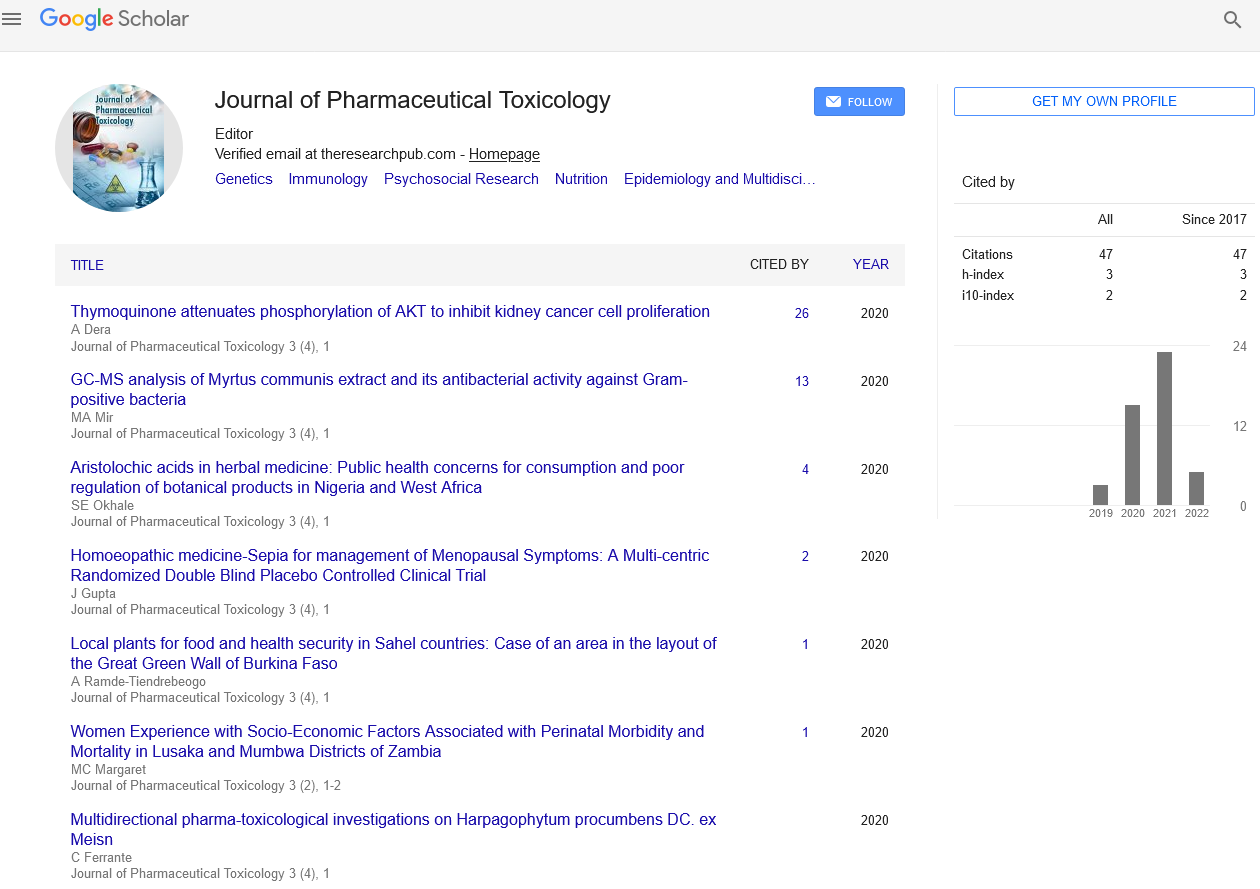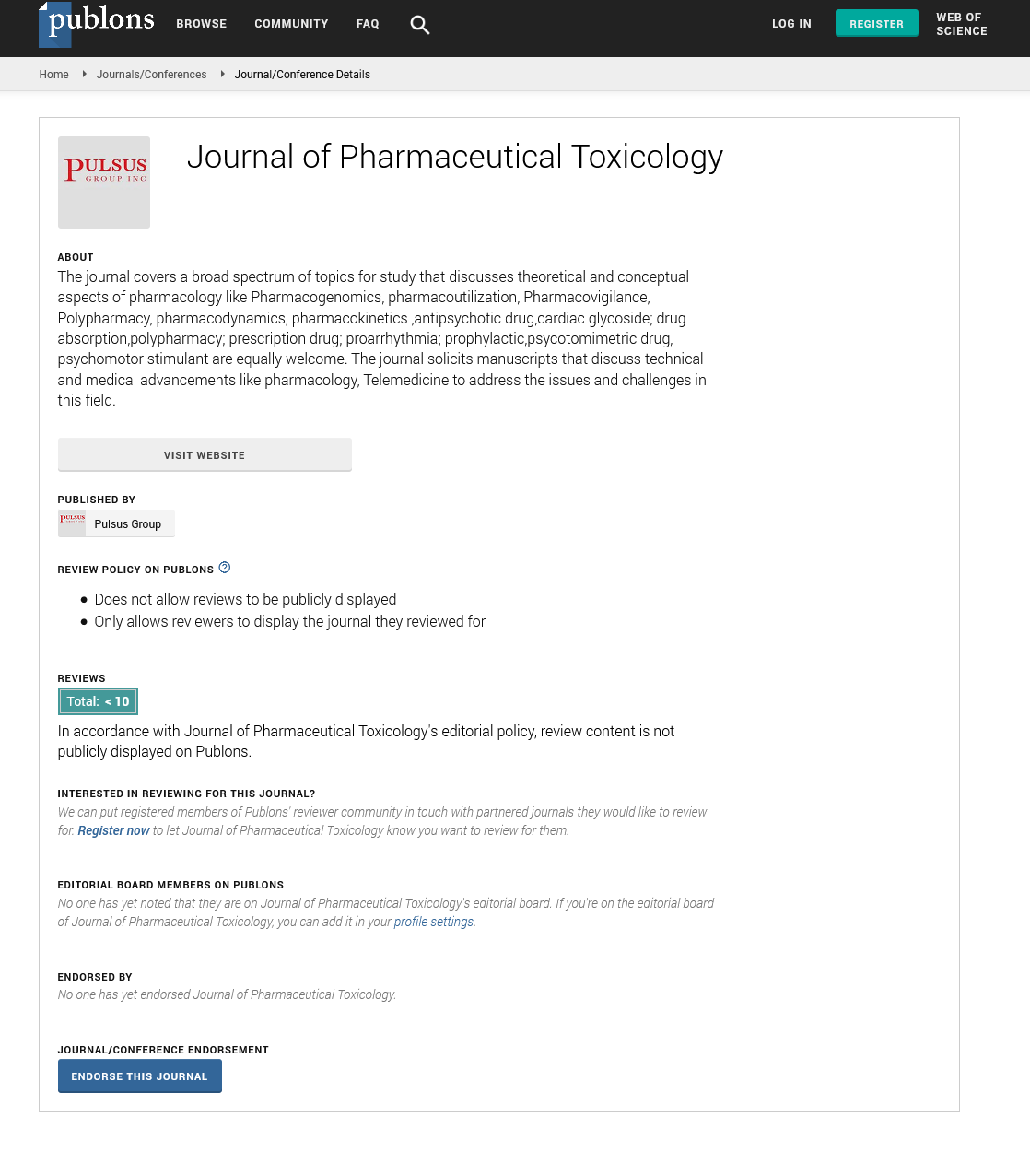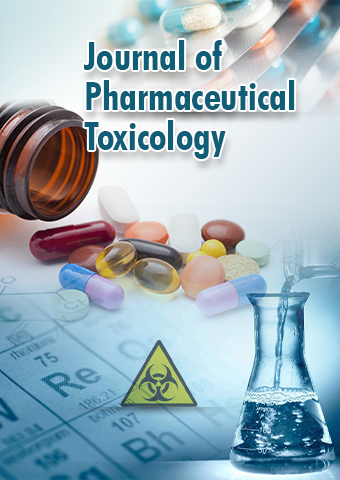Short Communication - Journal of Pharmaceutical Toxicology (2023) Volume 6, Issue 4
The Evolution of Pharmaceuticals: A Journey of Healing and Innovation
Wasan Jessica*
Department of Pathology, University of Sydney, Australia
Department of Pathology, University of Sydney, Australia
E-mail: wasan.jessica@gmail.com
Received: 01-August-2023, Manuscript No. oajpt-23-108571; Editor assigned: 3- August -2023, PreQC No. oajpt-23-108571 (PQ); Reviewed: 17- August -2023, QC No. oajpt-23-108571; Revised: 22- August -2023, Manuscript No. oajpt-23-108571 (R); Published: 28- August -2023; DOI: 10.37532/ jpt.2023.6(4).115-117
Abstract
In the vast landscape of medical science, pharmaceuticals have emerged as a cornerstone of modern healthcare. Over the centuries, these remarkable compounds have transformed the way we treat diseases and have significantly improved the quality of human life. This article takes you on a journey through the evolution of pharmaceuticals, from ancient remedies to cutting-edge therapies. The history of pharmaceuticals dates back to ancient civilizations, where healers and shamans utilized natural substances like herbs, plants, and minerals to alleviate ailments. Their knowledge, passed down through generations, laid the foundation for the development of pharmacology. Fast forward to the middle Ages, apothecaries began distilling and compounding these natural remedies, creating more standardized treatments
Introduction
The 19th century marked a pivotal moment with the establishment of modern pharmaceutical science. Chemists isolated active compounds from plants, such as quinine from cinchona bark to treat malaria. The discovery of anesthesia and antibiotics like penicillin revolutionized surgery and infectious disease treatment, saving countless lives. The 20th century brought unprecedented advancements in pharmaceutical research and development. The understanding of biochemistry and physiology allowed scientists to synthesize drugs artificially. Vaccines, once a breakthrough against infectious diseases like polio and measles, became routine preventive measures. Chronic conditions, previously considered untreatable, saw progress with medications that improved patients’ lives [1,2].
As technology advanced, so did the tools for drug discovery. High-throughput screening and computational modeling accelerated the identification of potential drug candidates. Biotechnology opened a new frontier, allowing the production of therapeutic proteins like insulin and growth hormones using genetically engineered organisms. The 21st century brought personalized medicine to the forefront. Genetic testing enables tailored treatments based on individual genetic profiles, maximizing efficacy while minimizing side effects. Precision medicine and immunotherapies have shown promising results against cancer and other complex diseases [3,4].
Material & Methods
Despite these triumphs, the pharmaceutical industry faces challenges. Developing a new drug is an arduous process that can take years and involves extensive testing for safety and efficacy. The cost of research and development is immense, leading to high drug prices, sparking debates on accessibility and affordability. In recent years, a shift towards rare and orphan diseases has gained momentum. Pharmaceutical companies invest in drugs for conditions affecting a limited number of patients, providing hope for those previously overlooked by mainstream medicine. Looking ahead, emerging technologies like gene editing, nanomedicine, and artificial intelligence present exciting opportunities for the pharmaceutical industry. Gene therapies offer the potential to cure genetic disorders at their root cause, while nanomedicine promises targeted drug delivery for enhanced precision.
In conclusion, pharmaceuticals have come a long way since ancient times. From humble origins in natural remedies to the sophisticated, personalized treatments of today, these medications have played a pivotal role in transforming healthcare. As technology continues to advance, the future holds even greater promise for pharmaceuticals, offering hope for a healthier and brighter tomorrow. In recent years, the field of pharmaceuticals has witnessed remarkable advancements that hold the promise of revolutionizing healthcare as we know it. From cutting-edge drug discoveries to innovative therapeutic approaches, the industry is continuously striving to tackle complex medical challenges and improve the well-being of individuals worldwide.
Results
One of the most significant breakthroughs in pharmaceutical research has been the development of personalized medicine. Traditional treatment methods often followed a one-size-fits-all approach, but with advancements in genomic and molecular research, scientists have now gained insights into how individual genetic makeup influences responses to medications. This has paved the way for tailored treatment plans, where medications are specifically designed to suit a patient’s unique genetic profile, leading to enhanced efficacy and reduced side effects.
Another area of great progress lies in immunotherapy. The immune system plays a crucial role in combating diseases, including cancer. Pharmaceutical companies have invested heavily in developing immunotherapies that harness the body’s immune response to target and destroy cancer cells selectively. These groundbreaking treatments have shown remarkable success in clinical trials, offering new hope for patients with previously untreatable cancers. Furthermore, advancements in biotechnology have enabled the development of biologics—medications derived from living organisms. Biologics have proven highly effective in treating conditions like autoimmune diseases, rheumatoid arthritis, and certain types of cancer. As research continues to uncover new therapeutic targets, the potential applications of biologics in various medical fields are virtually limitless.
Discussion
Beyond traditional small-molecule drugs, nanotechnology has emerged as a game-changer in drug delivery. By engineering nanoparticles and other nano-sized carriers, pharmaceutical researchers have improved drug stability, increased bioavailability, and enabled targeted drug delivery to specific tissues or cells. This has led to more effective treatments and reduced adverse effects, significantly enhancing patient outcomes. The integration of artificial intelligence and machine learning into pharmaceutical research has also proven transformative. These technologies are being utilized to analyze vast datasets, accelerate drug discovery, predict drug interactions, and optimize clinical trials. AI-powered algorithms can sift through extensive chemical libraries to identify potential drug candidates more efficiently than ever before, saving time and resources in the drug development process. While these advancements hold tremendous potential, they also bring ethical and regulatory challenges [5-7].
One of the most significant developments in the pharmaceutical sector is the rise of precision medicine. With advancements in genomics and molecular biology, researchers can now tailor treatments to an individual’s unique genetic makeup. This personalized approach has led to more effective and targeted therapies, particularly in the field of oncology. By identifying specific genetic mutations driving cancer growth, pharmaceutical companies have developed drugs that inhibit these targets, providing patients with better outcomes and fewer side effects.
Moreover, the advent of biologics has opened up new possibilities in treating complex and chronic diseases. Biologics, which are derived from living organisms, offer a diverse range of therapies for conditions such as rheumatoid arthritis, multiple sclerosis, and various types of cancers. These medications have shown great promise in halting disease progression and significantly improving patients’ quality of life. Additionally, the pharmaceutical industry has embraced digital innovation to enhance drug development and patient care. Advanced data analytics and machine learning algorithms have enabled researchers to sift through vast amounts of information to identify potential drug candidates quickly. Virtual clinical trials, telemedicine, and wearable health devices have also streamlined the drug testing process, making it more convenient for patients to participate and contribute to medical research.
Despite these positive strides, the pharmaceutical industry also faces challenges that demand attention and collaboration. Rising drug costs continue to be a pressing concern, limiting access to essential medications for many individuals. The industry must strike a balance between innovation and affordability, ensuring that life-saving treatments reach those in need. Additionally, the ongoing threat of antimicrobial resistance remains a critical issue that requires urgent action. Overuse and misuse of antibiotics have led to the emergence of drug-resistant superbugs, jeopardizing our ability to combat infectious diseases effectively. Pharmaceutical companies, healthcare providers, and policymakers must work together to develop strategies for responsible antibiotic use and promote the development of novel antimicrobial agents [8-10].
Conclusion
In conclusion, the pharmaceutical industry has made significant strides in recent years, transforming the landscape of medicine with personalized therapies, biologics, and digital innovations. These advancements hold the potential to bring about revolutionary changes in patient care and treatment outcomes. However, it is essential for the industry to address challenges such as drug affordability and antimicrobial resistance to ensure that the benefits of pharmaceutical advancements are accessible to all and continue to make a lasting impact on global health. In conclusion, the pharmaceutical industry’s ongoing dedication to research and development has resulted in groundbreaking advancements that are reshaping the landscape of healthcare.
Personalized medicine, immunotherapy, biologics, nanotechnology, and the integration of AI are transforming the way we approach disease treatment. As these innovations continue to evolve, patients can look forward to a future where illnesses that were once considered incurable become manageable, and overall global health improves for generations to come. However, it is essential to address ethical considerations and ensure that these advancements benefit all individuals in need, regardless of their socioeconomic status. In recent years, the pharmaceutical industry has witnessed remarkable advancements, revolutionizing the way we approach and treat various medical conditions. These breakthroughs have not only improved the quality of life for countless patients but have also extended life expectancy and reduced the burden of several diseases.
References
- Kadiyala R, Peter R, Okosieme OE et al. Thyroid dysfunction in patients with diabetes: clinical implications and screening strategies. Int J Clin Pract. 64, 1130-1139 (2010).
- Clark A, Jones LC, de Koning E et al. Decreased insulin secretion in type 2 diabetes: a problem of cellular mass or function. Diabetes. 50, 169-171 (2001).
- DeFronzo RA. Pathogenesis of type 2 diabetes: metabolic and molecular implications for identifying diabetes genes. Diabetes Reviews. 5, 177-269 (1997).
- Peppa M, Betsi G, Dimitriadis G et al. Lipid abnormalities and cardio metabolic risk in patients with overt and subclinical thyroid disease. J Lipids. 9, 575-580 (2011).
- Cettour-Rose P, Theander-Carrillo C, Asensio C et al. Hypothyroidism in rats decreases peripheral glucose utilisation, a defect partially corrected by central leptin infusion. Diabetologia. 48, 624-633 (2005).
- Ogurtsova K, Fernandes JD, Huang Y et al. IDF Diabetes Atlas Global estimates for the prevalence of diabetes. Diabetes Res Clin Pract. 128, 40-50 (2017).
- Zhou Z, Mahdi A, Tratsiakovich Y et al. Erythrocytes From Patients With Type 2 Diabetes Induce Endothelial Dysfunction Via Arginase I. J Am Coll Cardiol. 72, 769-780 (2018).
- Sprague RS, Stephenson AH, EA Bowles et al. Reduced expression of Gi in erythrocytes of humans with type 2 diabetes is associated with impairment of both cAMP generation and ATP release. Diabetes. 55, 3588-3593.
- Blaslov K, Kruljac I, Mirošević G et al. The prognostic value of red blood cell characteristics on diabetic retinopathy development and progression in type 2 diabetes mellitus. Clin Hemorheol Microcirc. 71, 475-481 (2019).
- Venerando B, Fiorilli A, Croci G et al. Acidic and neutral sialidase in the erythrocyte membrane of type 2 diabetic patients. Blood. 99,1064-1070 (2002).
Google Scholar, Crossref, Indexed at
Google Scholar, Crossref, Indexed at
Google Scholar, Crossref, Indexed at
Google Scholar, Crossref, Indexed at
Google Scholar, Crossref, Indexed at
Google Scholar, Crossref, Indexed at
Google Scholar, Crossref, Indexed at
Google Scholar, Crossref, Indexed at
Google Scholar, Crossref, Indexed at


